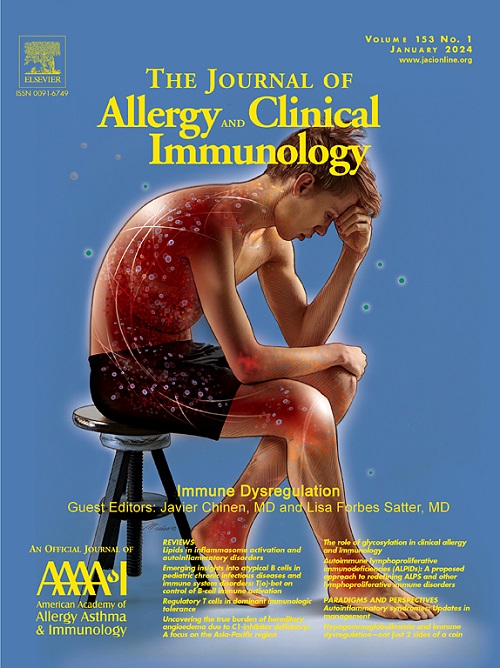特应性皮炎、白癜风和斑秃的统一治疗途径。
IF 11.4
1区 医学
Q1 ALLERGY
引用次数: 0
摘要
新出现的证据显示,特应性皮炎、白癜风和斑秃之间存在显著的流行病学、遗传学和免疫学联系,挑战了之前关于其独特致病和分子特征的既定概念。探索这些共性不仅增强了我们对每种疾病发病机制的理解,而且还支持对这些经常共存的疾病制定统一的治疗策略。本文综述了在三种情况下共享的关键免疫参与者,包括细胞因子、免疫细胞和信号通路。基于这些见解,我们还评估了一系列治疗方案——从fda批准的治疗方案到目前正在临床试验的治疗方案——以及提出的未来治疗目标。这种全面的方法旨在以更精确的方式推进我们对这些相互关联的自身免疫和炎症性疾病的管理。我们知道什么?•特应性皮炎、白癜风和斑秃在流行病学上有重叠,在这些疾病的患者中观察到显著的共发。•虽然临床表现不同,但这三种情况表现出遗传和免疫学上的重叠,例如共享的细胞因子轴失调。•包括各种JAK抑制剂在内的靶向治疗已经证明对所有三种疾病都有效,这突出了当这些疾病同时发生时统一治疗策略的潜力。还有什么是未知的?•趋同细胞因子和免疫通路在特应性皮炎、白癜风和斑秃发展中的作用尚不完全清楚。了解这些交叉点可以为在管理这些共存疾病方面取得变革性进展铺平道路。本文章由计算机程序翻译,如有差异,请以英文原文为准。
Converging Paths Towards Unified Therapeutic Approaches in Atopic Dermatitis, Vitiligo, and Alopecia Areata.
Emerging evidence reveals significant epidemiological, genetic, and immunological connections between atopic dermatitis, vitiligo, and alopecia areata, challenging previously established notions of their distinct pathogenic and molecular signatures. Exploring these commonalities not only enhances our understanding of each disease's pathogenesis but also supports the development of unified treatment strategies for these frequently co-occurring disorders. This review examines key immune players shared across the three conditions, including cytokines, immune cells, and signaling pathways. Building on these insights, we also evaluate a range of therapeutic options-ranging from FDA-approved treatments to those currently in clinical trials-alongside proposed future therapeutic targets. This comprehensive approach aims to advance our management of these interconnected autoimmune and inflammatory disorders with greater precision. What do we know? •Atopic dermatitis, vitiligo, and alopecia areata share epidemiological overlap, with notable co-occurrence observed in patients across these conditions. •While distinct in their clinical presentations, these three conditions exhibit genetic and immunological overlap, such as shared cytokine axes dysregulation. •Targeted therapies, including various JAK inhibitors, have demonstrated efficacy across all three conditions, highlighting a potential for unified therapeutic strategies when these conditions co-occur. What is still unknown? •The role of converging cytokines and immune pathways in the development of atopic dermatitis, vitiligo, and alopecia areata is not yet fully understood. Understanding these intersections could pave the way for transformative advancements in managing these co-occurring diseases.
求助全文
通过发布文献求助,成功后即可免费获取论文全文。
去求助
来源期刊
CiteScore
25.90
自引率
7.70%
发文量
1302
审稿时长
38 days
期刊介绍:
The Journal of Allergy and Clinical Immunology is a prestigious publication that features groundbreaking research in the fields of Allergy, Asthma, and Immunology. This influential journal publishes high-impact research papers that explore various topics, including asthma, food allergy, allergic rhinitis, atopic dermatitis, primary immune deficiencies, occupational and environmental allergy, and other allergic and immunologic diseases. The articles not only report on clinical trials and mechanistic studies but also provide insights into novel therapies, underlying mechanisms, and important discoveries that contribute to our understanding of these diseases. By sharing this valuable information, the journal aims to enhance the diagnosis and management of patients in the future.

 求助内容:
求助内容: 应助结果提醒方式:
应助结果提醒方式:


